A Fistful of Campers, Mirleft to Sidi Ifni
Zagan the motorhome’s sat below a cliff, atop which sits Sidi Ifni, part of Spain from 1860 until 1969, and an unknown entity to us. We drove into the town, through streets strewn with mud and pebbles (presumably from the recent bad weather), past walled compounds eye-wateringly rammed with motorhomes and into Camping El Barco (N29.382631, W10.17627).
Three of the campsites here, and part of the main road, were wiped off the map in Nov 2014 by a torrent of flood water after several days of rain. At least two of them are back. It looks like they’ve been rebuilt, maybe in new places, but probably not… We’ve a beach-front spot peering out over the Atlantic, but the site itself is, shall we say, charmless. It costs 70Dh a night to stay here without electricity (€7). We’re running our fridge on gas and relying on solar to avoid the additional 20Dh for hook-up.
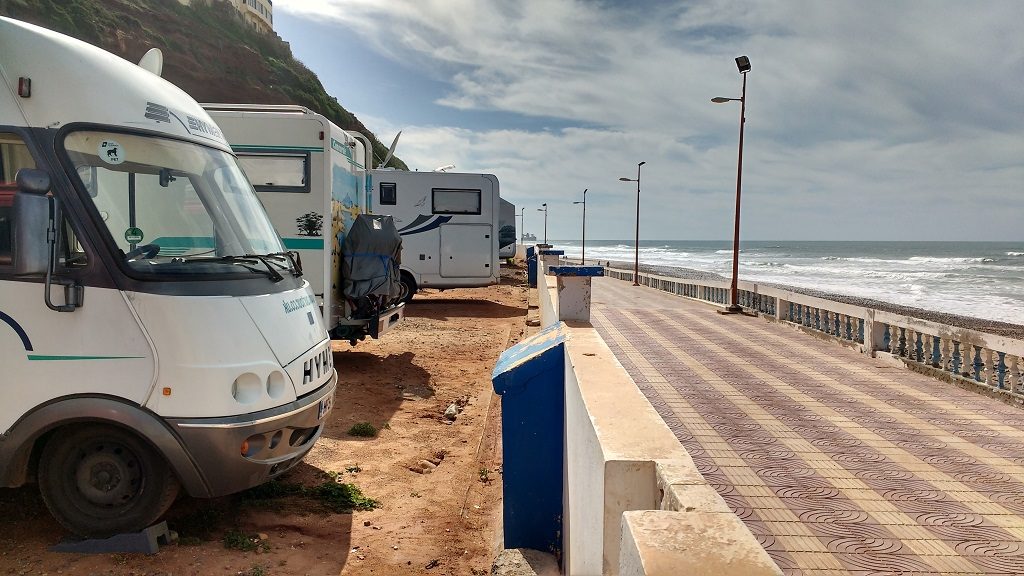
Camping El Barco, Sidi Ifni, Morocco
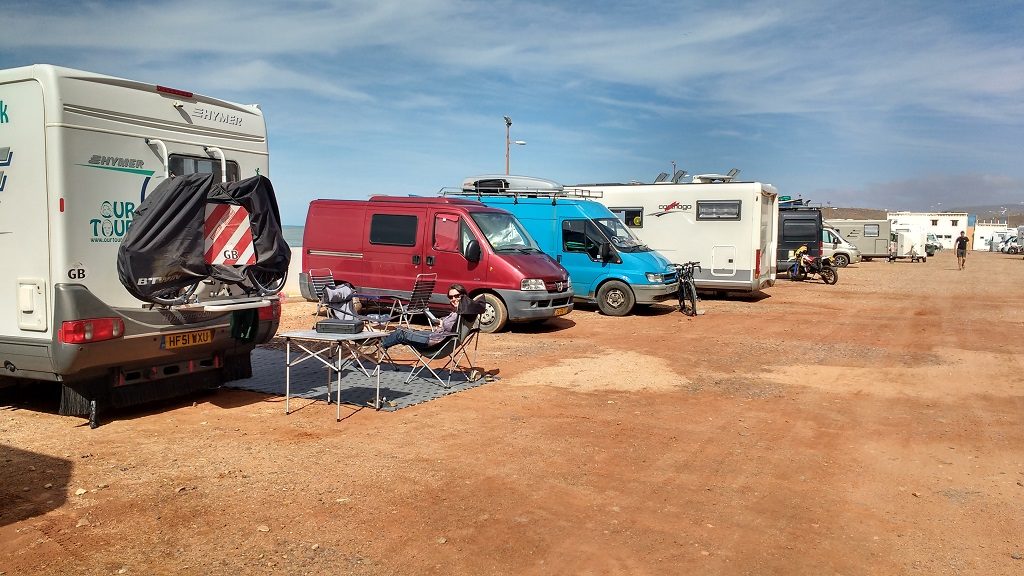
Camping El Barco, Sidi Ifni, Morocco
Oh man, there are a LOT of motorhomes in this here part of the world. Back up in Tiznit we walked into town, popping into the municipal camping up against the medina walls to see Peter and Elaine (Heidi Hymer on Facebook). They’d gotten one of the gold dust spots in the 200 pitch site, and we had chance for a catch-up chat before heading into the old town. These guys are interesting folks, and have a great mindset for getting the most out of the camper lifestyle and Morocco too.
I’d read on Facebook how Peter had bought the freshest chicken possible, having one killed, plucked, cleaned and roughly chopped for him from a shop in the medina. I’ve been eyeballing these places from afar and have come to the conclusion I need to pass the Chicken Test too. But maybe not on Valentine’s Day… Peter also had an interesting solution to the Great Moroccan Gas Question. There are no LPG refill stations in Morocco, so you have limited options (see end of post).
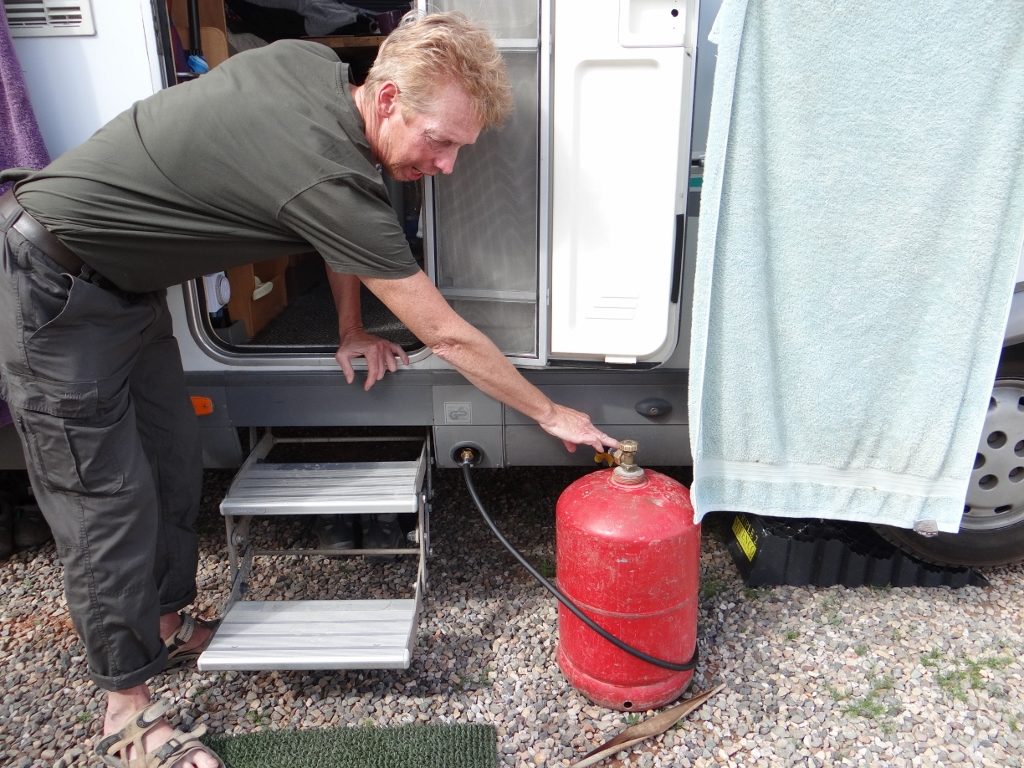
Peter’s Moroccan gas bottle attached direct to the LPG refill point

Door of the day: washing drying in Tiznit
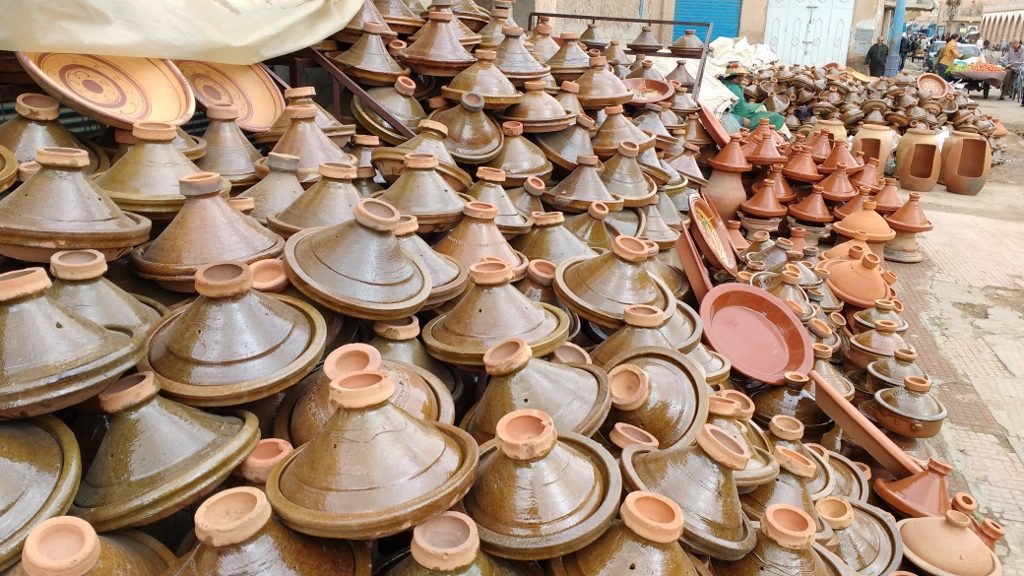
Tagines in the Tiznit Medina
While in town we decided to buy a sandwich from a roadside cafe. Enquiring on price, the chaps wrote down 10Dh, 13Dh and 15Dh, so the maximum cost for what was effectively a kebab and chips was €1.50. We opted for the 10Dh one and the guys carried out a table and chairs into the street when we turned down their offer to let Charlie into the cafe. Sat at the table, supping a lemonade, we watched the world go by. Although not all of it went by. One toothy chap, clearly not 100% sane, spotted us and started to try and communicate, using words which he must have thought were European in some way, but which meant nothing to us. We smiled and nodded, and he rambled on. A group of teenagers, dressed in jeans and dark tops like their Italian counterparts, shouted a few things at the chap, apparently amused by what we had to assume was a well-worn routine. The cafe owner tried shouting something, but he wasn’t perturbed and went on for what felt like an hour. Eventually, as we all worried he might do something even odder, he walked off. Turning round to shrug at the cafe owner, we shared a laugh. We weren’t laughing at the man, just the whole absurdity of things which happen from time to time.
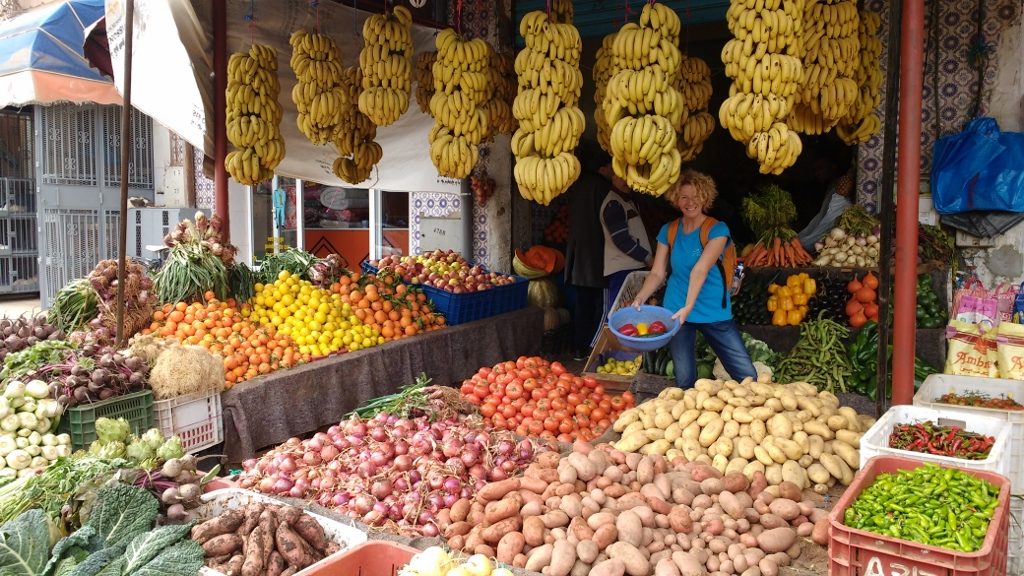
Jules buying fruit from a colourful stall in Tiznit
The site we were on was a good couple of km from the town, and we ended up having to carry Charlie some of the way back as he’d worn through the skin on his paw on one side, dragging his feet with the struggle against arthritis. That’s frequently the issue with campsites for us: they’re miles from anywhere, and that’s why we like to mix up campsites, aires and free camping.
An afternoon of wind and rain greeted us as we arrived back at the campsite, along with Martin and Ann, a couple we last saw in Croatia last spring. It is indeed, a small world. After a good catch up over a brew, we waved goodbye to them during a torrential downpour.
As the rain gave up the fight the following morning, we opted to leave Tiznit and head out to the coast. Before leaving we nipped over to see Ian and Marit and their wonderful boys Victor and Bowen. Having last seen ’em at Haukland Beach in the Lofotens (Norway), we’ve each done a few thousand miles to find ourselves on the same spot here in North Africa. Bonkers. Their motorhome is a 4WD animal of a thing, a beast aptly named The Rhino (rhinocamper.com), and over time the nickname’s grown into a campaign to help Save the Rhino. The van itself has become a horned piece of art (the horn was made here in Morocco), an advert for the charity and a place on which you can sign your name in support. It looks incredible, and if you want to support them, you can donate a few quid here.
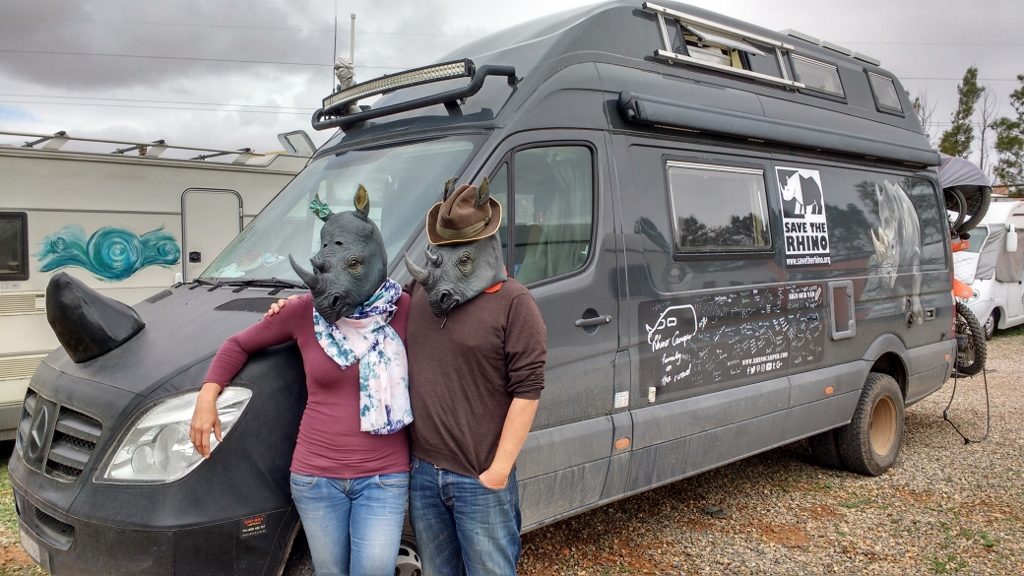
Ian and Marit are in there somewhere!
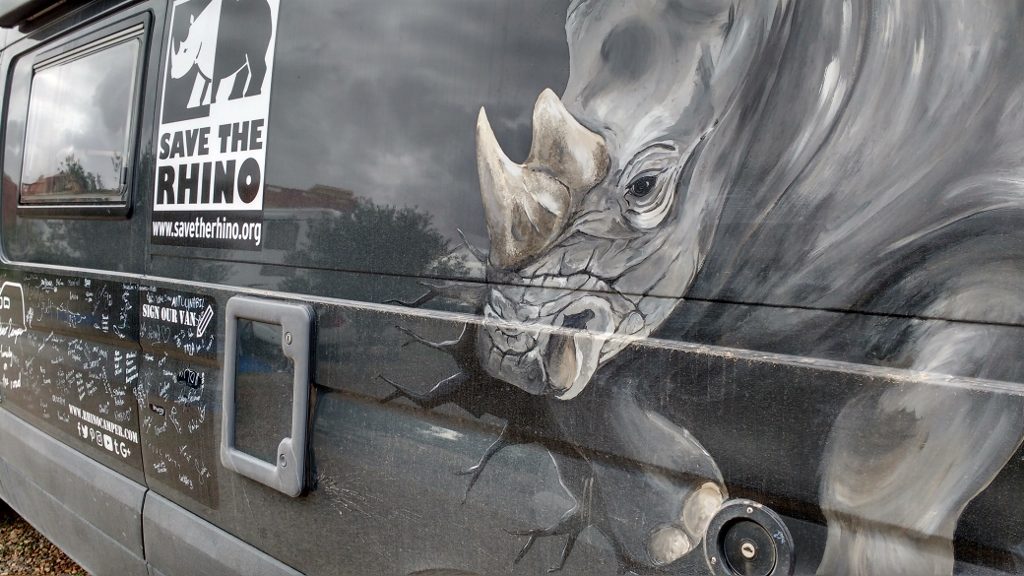
Fantastic artwork on The Rhino Camper
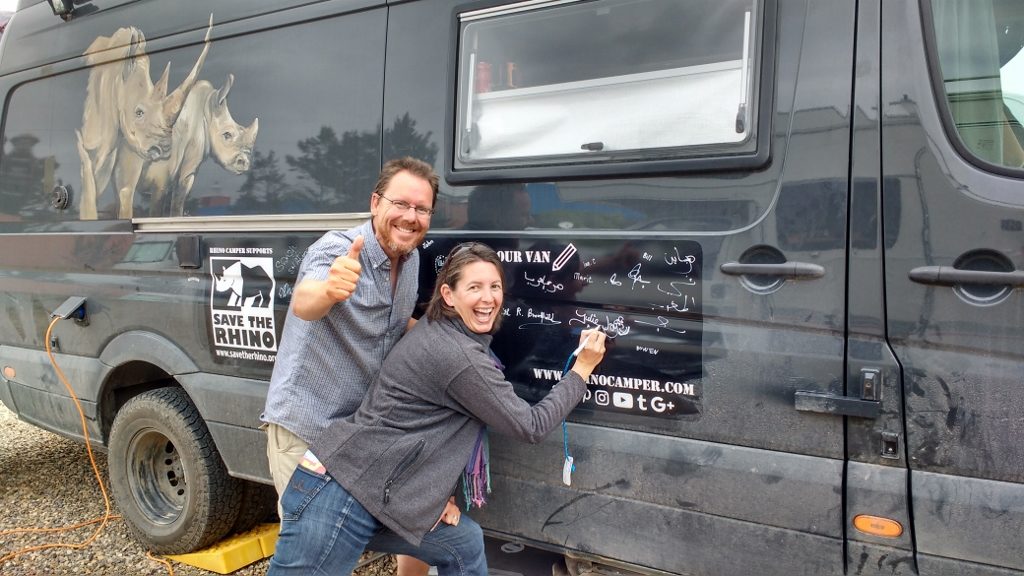
The OurTour.co.uk Crew Signing The Rhino Camper and donating to Save the Rhino
Leaving Tiznit on the R104, the hills rose up ahead of us and the earth went orange, dotted with circles of green. The watering can sky’s brought out the colour in the hardy arid-weather plants down here, and it was quite a beautiful drive, gently rolling through the hills south-west back to the Atlantic. Morocco’s river beds are often dry, ripped-edged and boulder-strewn, and many of them are crossed with semi-bridges, raised road with concrete pipes for the water to flow through. The road surfaces sometimes roughens as you cross these part-road-part-ford sections, evidence of past debris battering them. A couple of times these past days we’ve crossed river beds on new fords, alongside the ruined old one, presumably victims of the 2014 floods. It’s usually dry here, but when it rains, it can clearly be disastrous.
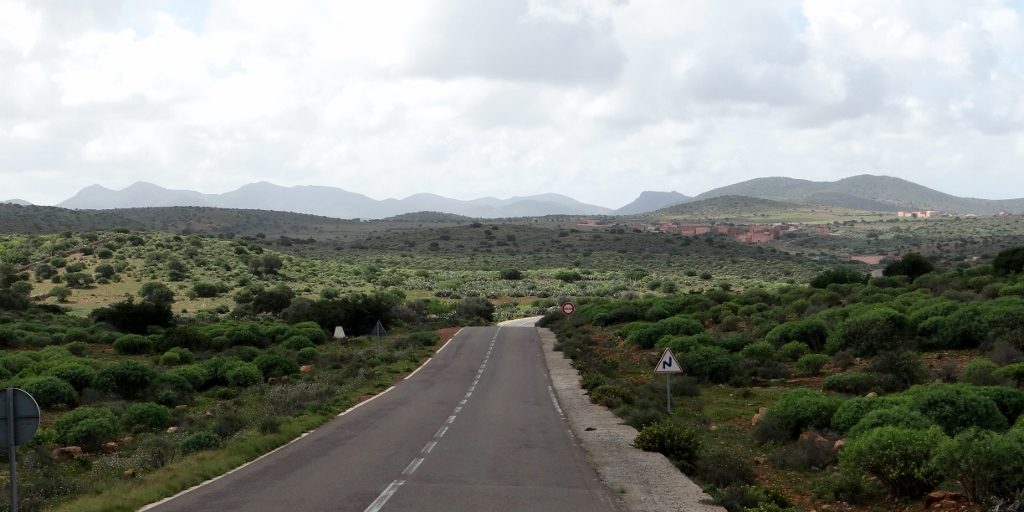
Through rolling hills and cacti on the R104
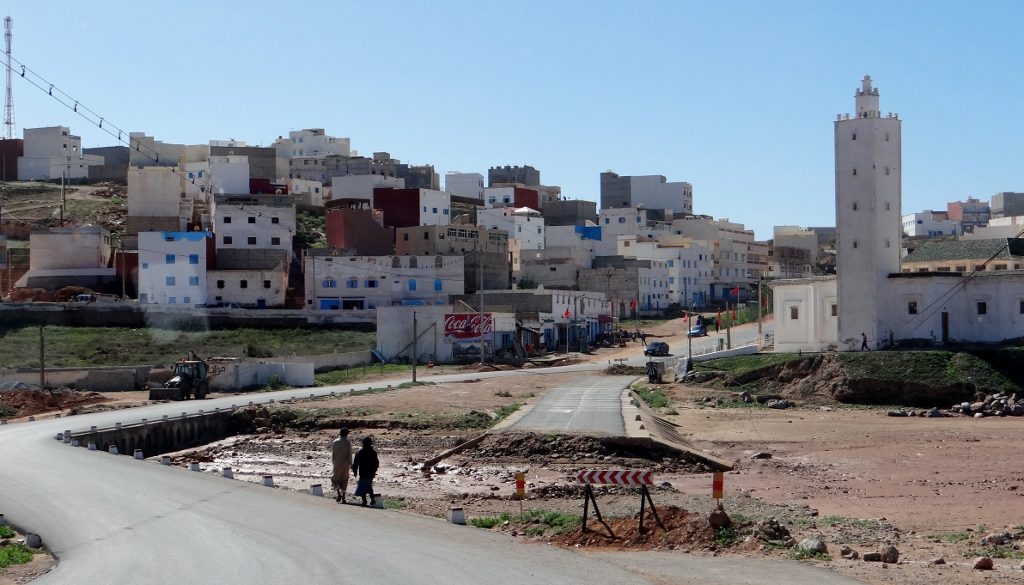
An example of a washed-out ford in Morocco
Our destination was a small guardian parking area just outside Mirleft (N29.590328, W10.036889), recommended to us by Martin and Ann. The beach-side parking was a lovely spot, costing us all of 10Dh, with direct access to the beach, and steps up to the plush villas overlooking the sea. The villas form a break-away part of the town, which is a few hundred metres further on alongside yet another section of spanking new tarmac.

Guardian parking at Mirleft – read on before you decide to come here though
Mirleft’s a work-a-day kind of place, easy going, authentic, low hassle, where you can browse fruit stalls, try on slippers and sup a mint tea without pressure or indeed a lot of money. We had three drinks for 90p in a cafe, again sitting and watching the array of life go past. Even in a sleepy backwater place, Morocco puts on an endless background show.

Locals walking the high street in Mirleft
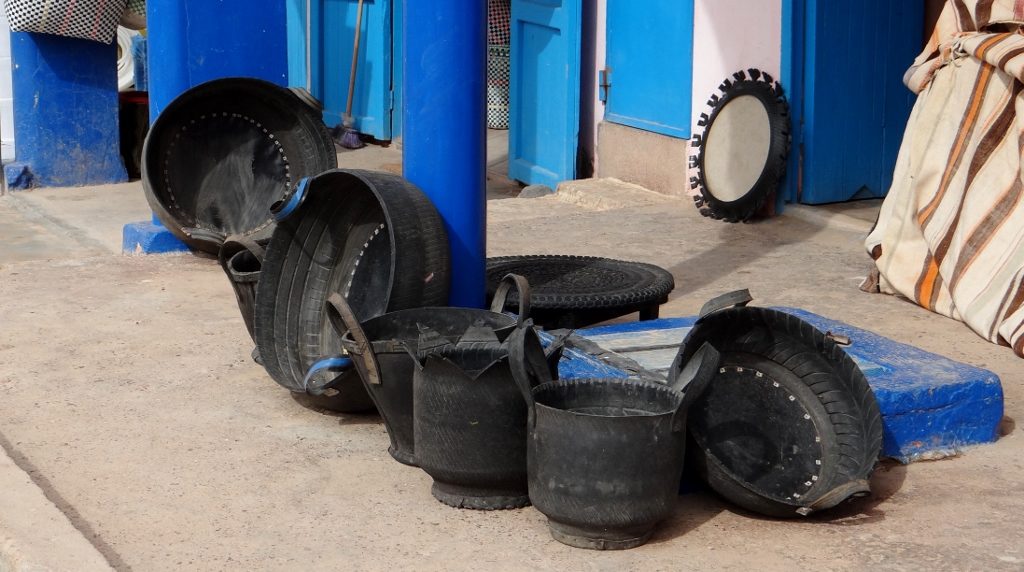
Fancy a bucket made from an old tyre? Mirleft’s your place
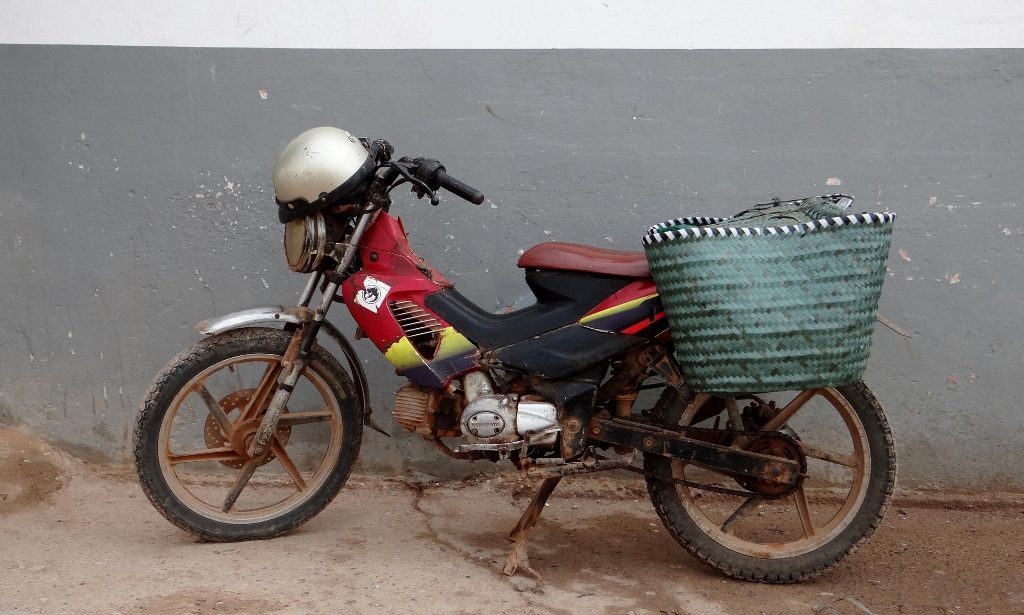
Now that’s what I call a set of panniers
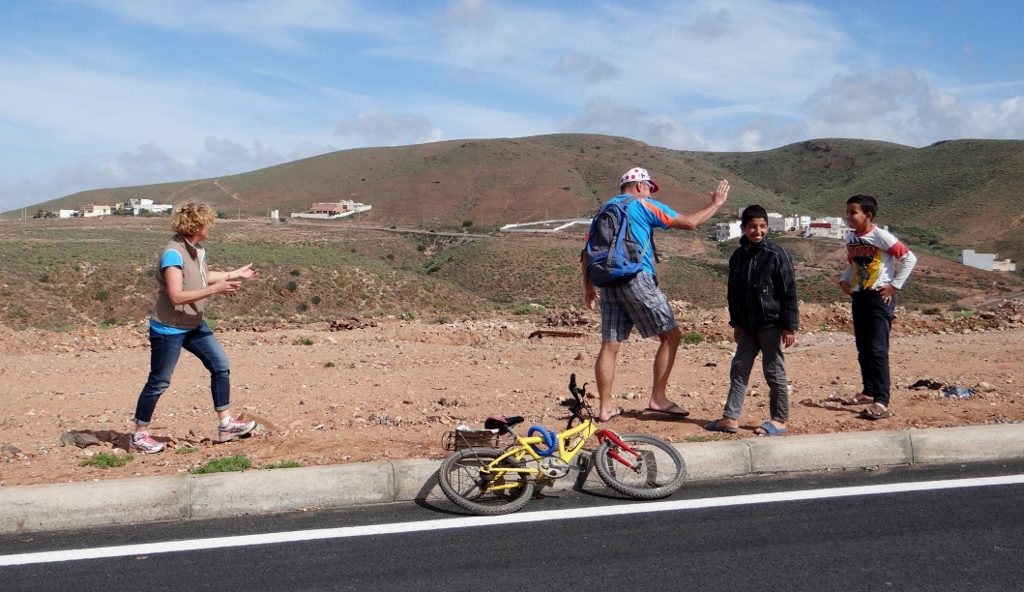
Phil and Jules having fun with some local nippers
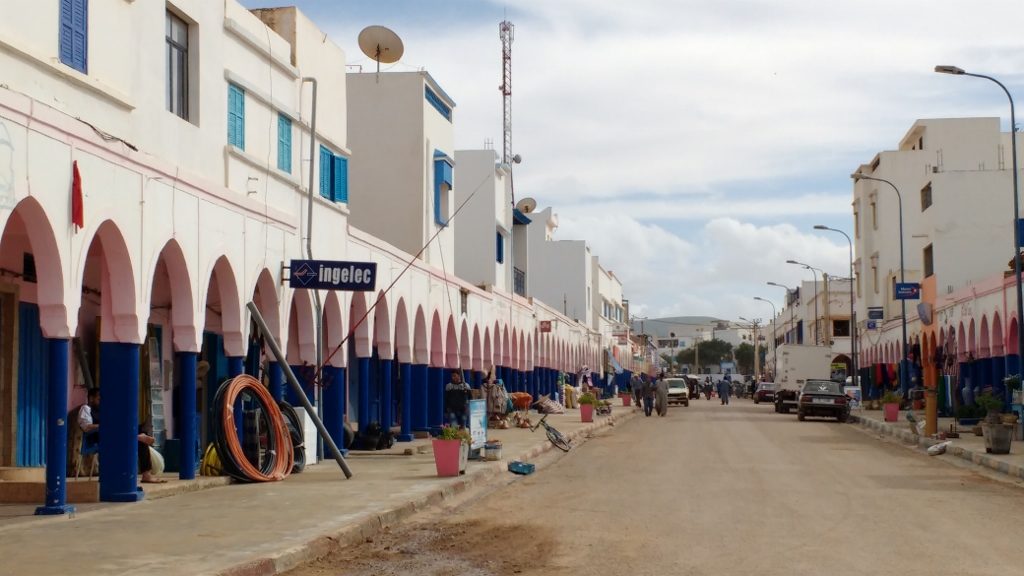
Mirleft
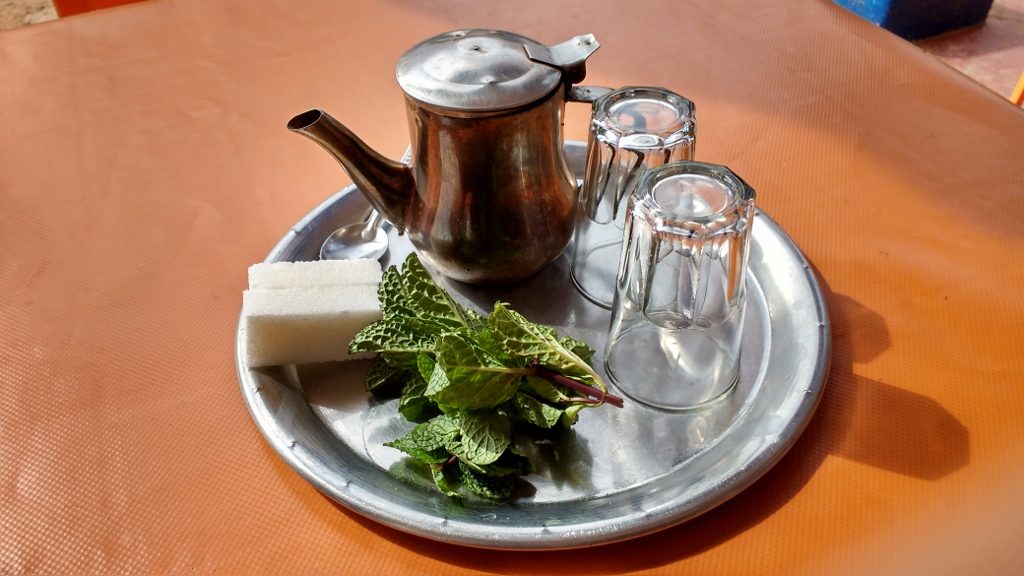
Mint tea in Mirleft – just a little bit of sugar!
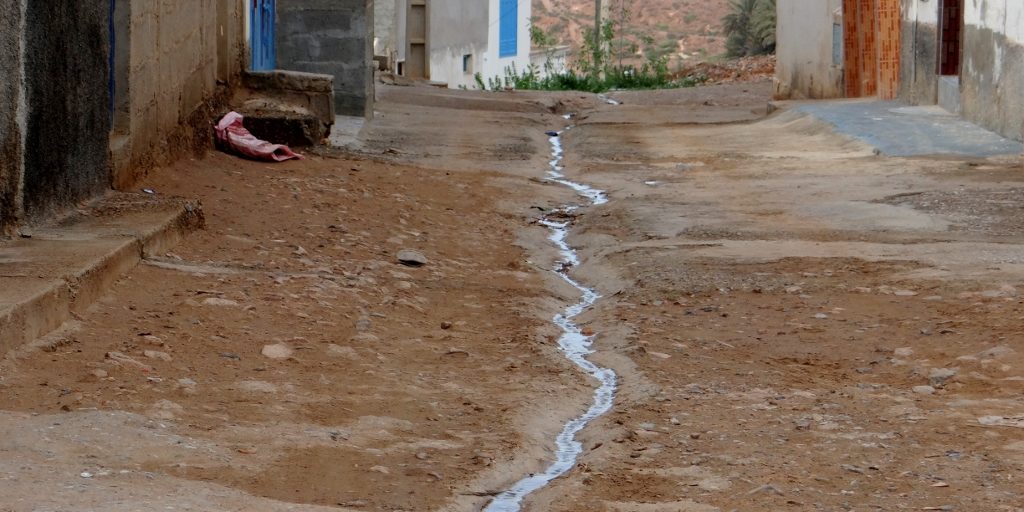
This is Morocco: walking down a street with an open drain
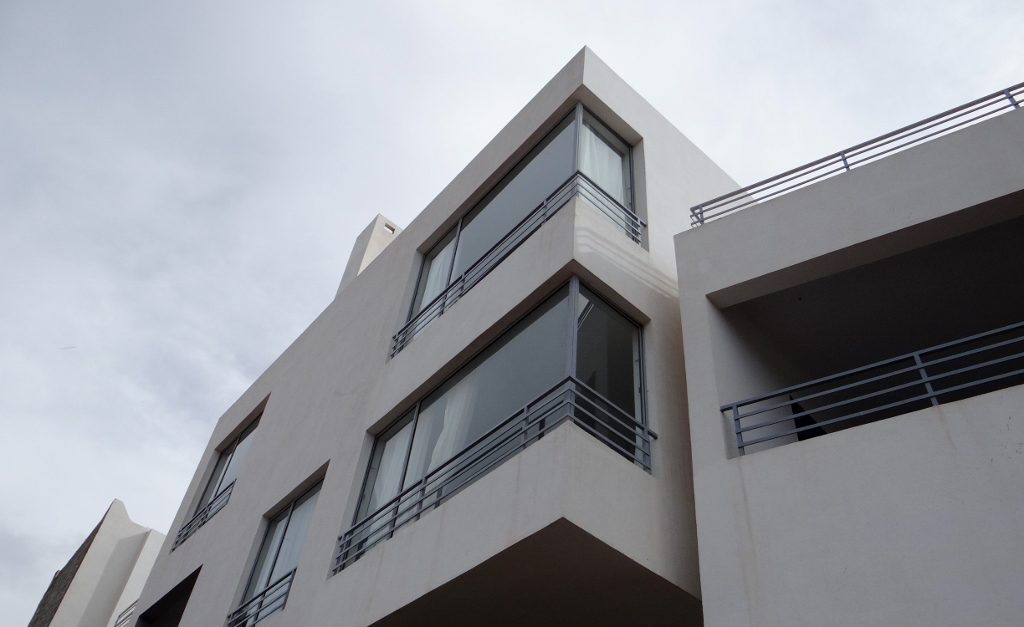
And at the end of the road is this place: all glass and steel
Phil and Jules were already at the parking area when we arrived, and had spoken with the guardians, working out they rented the parking area from the government for about €3000 a year. The guardians then charge us motorhomers 10Dh (€1) a day, so as they need an average of 8 motorhomes a day to break even. We were one of around 30 vans of all different nationalities, which proved too many. A local called the police and this morning they arrived and gently passed on the message: daytime parking was fine, but not overnight.
By the time we left more than half of the other vans had too, and some of them are here on the same site as us now. We stopped at Erkounte Park on the way, a new 100-pitch site close to the sea, but didn’t stay. It has a good reputation but wasn’t for us at this moment in time: I for one am a bit taken aback by just how many folks are over-wintering down here in motorhomes, often on sites in the middle of nowhere. Horses for courses: it’s just not my bag at this period in life.
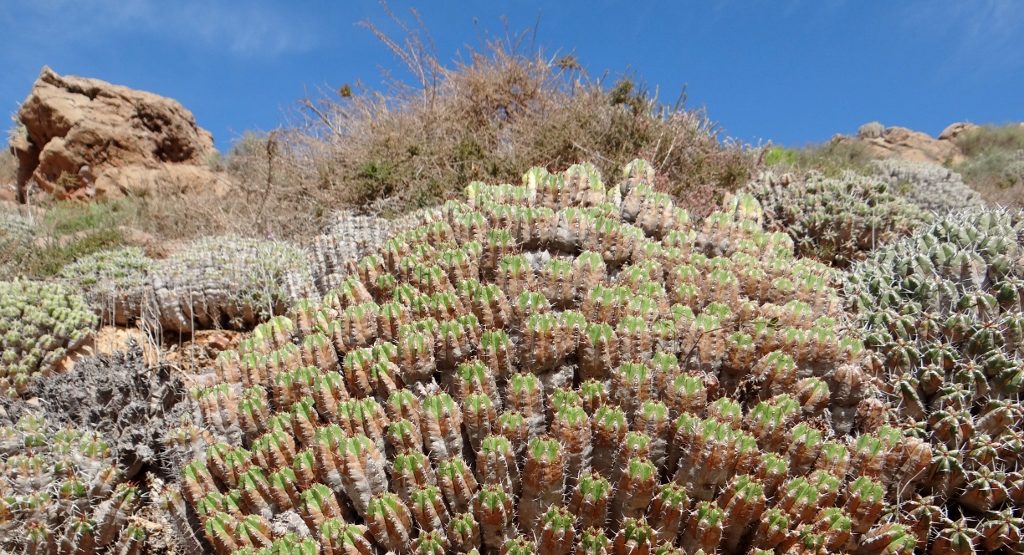
Some of the desert foliage we’re in amongst down here
The plan now is to stay here a day or three, and spend a bit of time looking around the town. The plan’s then to head south as far as Guelmim, north to Tafraoute (to buy some yellow slippers) and then start the trek east into the desert areas around Foum-Zguid, Mhamid and eventually Merzouga.
Cheers folks, Jay
The Great Moroccan Gas Question
There are no LPG/GPL/Autogas refill stations in Morocco, so if you have a refillable LPG system (GasIT, Gaslow etc) then you can’t just rock up at a petrol station or gas station here and get a top-up. So what do you do? As far as I can tell, these are the options available to you:
- Find one of the few places which will take your refillable LPG bottle away and bring it back full. Advantages of this: you have gas! There are two we know of – one near Marrakech and one closer to Agadir. Disadvantages: (a) you have to dismantle your LPG system and give them the bottles, then refit them (b) there are so few places you can get it done and (c) there are rumours of occasional poor quality gas bunging up delicate fridge and water heater burners – I have zero idea how accurate these are.
- If you have steel balls: find a local who’ll refill your bottle the local way. Word is they remove the top from your empty bottle and place it in the shade. They then remove the top from a full bottle and, with it held in the sun, pour the liquid gas into the empty bottle. Well, this is Morocco…
- Eke out your refillable LPG gas. We had 17Kg of gas when we left Spain, and are using electrical hook-up a lot to avoid using it all. We’re cooking with an electrical hotplate, running the fridge on mains, boiling water with an electric kettle, and heating with an electric fan. There are lots of campsites (walled compounds) here in Morocco, and although brown outs and black outs happen, they’re not a massive problem. We have a gas stove which takes canisters so we can cook outside when not on hook-up, or you can get a small local bottle and screw-in stove for about €10, which we might do soon.
- Set your system up so you can pop a Moroccan gas bottle into your lockers. This has the same ‘dirty gas’ risk as before, but makes it easier to swap the bottles over, which are everywhere here, and they’re cheap.
- Buy a Moroccan gas bottle and regulator, and ‘backfill’ your gas system into an external gas BBQ point, if you have one. Again the possible risk of dirty gas, plus the fact you need a gas bottle and pipe sat unprotected alongside your vehicle.
- Buy a Moroccan gas bottle and attach it directly (without a regulator) to the LPG refill point. Again risk of dirty gas, and the bottle has to sit alongside the van, but if you don’t have an external gas point, might be the best option. This is what Peter had done, using a hose bought at home, and we all pondered if it would work. There’s a one-way valve on the LPG refiller, and we’ve no idea whether the pressure in the bottle would remain enough to keep it open. My hat’s off for thinking of it, and for giving it a go.
Edit: more info from Peter Borthwick on his gas solution for Morocco. Thanks for letting me share this Peter.
“re. the gas issues for those interested ; I can’t claim credit for the idea of connecting a local bottle to your refill point. That came from ‘Gaslow’, the company that fitted our refillable bottles. I bought the hose from them online and an adapter to connect a camping gaz bottle too. They also sell just about every adapter and part for different instalations and countries. The red bottle I’m using in Maroc is propane and more reliably clean than the blue butane bottles (so I’m told). It cost me 110dr for the bottle and 40dr for the gas, available just about anywhere here”
“And more.. I’ve also exchanged a European CampingGaz bottle here in Morroco. The ones here are refilled here (with butane I think, though I have seen a few painted red or orange?) It’s dirt cheap. I payed 11dr/€1 for the gas, but you’ll never be able to change a Maroccan bottle for a European one – they are VERY beaten up and battered. You’d be much better off just buying one here outright if you want one. It’s bound to be cheaper than a refill in the UK, which last time I checked was around £15! We already had a burner to screw on top, but the Moroccan ones look like they’re better and are widely available”


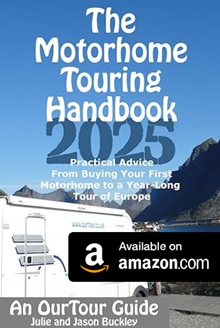
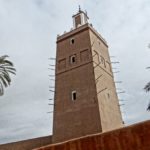

Method 5 had worked for us for three years we always take the moroccan bottle back yo UK for emergency use if wilding and run out of LPG. Only one bottle ever in 2015 was ‘dirty gas’ and caused soot in the vent. All others and we stick to the red ones now have been fine. If you are looking for traquility Plage Blanche is great been here 6 days, must brinh water, food and empty casette 60km to nearest town but good tarmac road from N12.
Thanks for the info Sam, cheers, Jay
Thanks for your accurate information about Lpg. We are going to Morocco in April for two month and for the first time and we were just wandering how to solve this problem. Your blog is perfect. Enjoy and keep us informied.
Regards,
Vesna
You’re welcome Vesna. We are two months in and have used about 10Kg of gas. We are using campsite electricity and showers most of the time, and have enough with 17Kg LPG that way to last us 3 months. Cheers, Jay
Thanks for the info which then led me to the actual gaslow part required. Sounds like a perfect fix. If you are bit dim like me, this may help give a clear explanation.
This is from the gaslow site and explains that the tank is not refilled by the liquid gas but the vaporised gas passes through the empty gaslow tank from the maroc gas propane attached to the refill nozzle with this adapter:
http://www.gaslowdirect.com/epages/cyujrhdmmu67.sf/en_GB/?ObjectPath=/Shops/cyujrhdmmu67/Products/01-4500
The Gaslow Reserve Cylinder Connection Hose enables the connection of a reserve cylinder to the Gaslow filler point.
Perfect if you are on site and don’t want to move your caravan to find a filling station.
The hose screws into the internal thread on the Gaslow Fill Kit.
The other end of the hose connects directly to any 21.8LH cylinders or our range of Gaslow 21.8LH Adapters, so you can connect to all European cylinders.
The gas will be drawn from the reserve cylinder, through one of the refillable cylinders to the regulator.
Note that it will not transfer liquid gas into the refillable cylinder, so gas from this cylinder will only be used if the refillable is empty.
You’re welcome and thanks in return for the explanation and the link. Jay